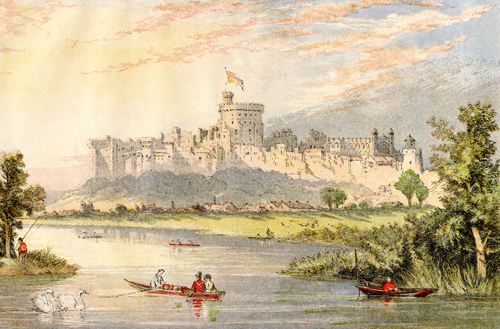The Wars of the Roses was a civil war fought in England on and off over the course of about fifty years in the mid to late 1400s. It was known to its contemporaries as the Cousins' War because it was a war for the crown of England fought between two lines of the same family; those lines were cousins to each other.
There are a lot of major players involved in the Wars of the Roses, both men, and women. With so many of them having the same first names as each other, over three to four generations, it is sometimes difficult for those not intimately familiar with the conflict to keep them all straight. But, each player has an intriguing biography and a unique role within the war. Without any of these players, the war might have looked very different from it did, or even have turned out differently in a way that would change the way modern Britain looks and is governed.
Here is the first in a series of biographies of the major players of the Wars of the Roses, and what they contributed to the war itself. We'll start with one of England's best-known and most controversial medieval queens, Elizabeth Woodville.
Elizabeth Woodville, England's First Domestic Queen
In an age where there had never been a true Queen Regnant of England (Matilda is the closest they came, back in the 1200s, during another civil war, with the outcome being her son was named heir of king Matilda was fighting for the throne, after a brief period of taking the throne for herself and calling herself and Empress, rather than a queen) English kings had always married foreign princesses in order to create strategic alliances with other countries. Elizabeth Woodville was English, born and raised in the country, and already a subject of the king. The fact she was not foreign was just one of the things that made her controversial with the English people from the beginning.
Born to Jacquetta of Luxembourg and Sir Richard Woodville as their eldest child, Elizabeth had royal roots on her mother's side. Jacquetta was Luxembourg royalty, who came to England as a teenager to marry an uncle of King Henry VI. This marriage made her a duchess and the second highest ranking woman in the land. Jacquetta caused controversy two years later, after her husband died, by marrying his squire, Sir Richard Woodville. It was a love marriage, and she and Richard were briefly banished from court for it, but it did not last long. They were forgiven, Richard was made a baron, and they had a large family of children together.
Elizabeth married Sir John Grey, a member of an old, noble house in England. The Wars of the Roses were just getting started when they married, pitting the Lancaster side of the royal family against the York side. Elizabeth's husband fought for the Lancastrian side and was killed in battle. By that time, she had borne him two sons, Thomas and Richard Grey. John's mother, however, would not release Thomas and Richard's inheritance to them.
So, Elizabeth took her boys out on the road one day when she knew the New York king (who had recently deposed Henry VI), Edward IV, would be riding by, and she caught his attention. He stopped, legend says, because she was so beautiful, the most beautiful woman in England at the time. He promised to help her get her sons' inheritance released to them. Edward IV came back again with the appropriate paperwork for her to sign, and something more… a declaration of love for her.
They were married in almost-secrecy, with only Jacquetta, a choir boy, and the priest who wed them as witnesses. Edward IV waited a few months to announce the marriage, leaving Elizabeth waiting at her parent's house, until his cousin and chief advisor, Richard Neville, declared he was nearly done with negotiations for Edward IV to marry a French princess. Edward then called Elizabeth to court and announced he could have no French queen, as he already had an English one.
This caused a scandal, not only because Elizabeth was English and a commoner (because her father was not of noble birth), but because her family fought against Edward's family in the war, as did her late husband. It was also scandalous because, as a widow, she was not a virgin, which was traditional for medieval English queens. Like her parents before her, Elizabeth threw off social norms and customs to marry for love.
Elizabeth was crowned queen in a traditional coronation ceremony, but Richard Neville was enraged that his efforts to secure a French alliance were thwarted by his cousin's lust for Elizabeth. He never liked her. In fact, Richard Neville began making plans to overthrow Edward and put Edward's younger brother, George, on the throne instead.
These machinations brought about more battles in the Wars of the Roses. During one of them, Edward IV was deposed, and Henry VI was put back on the throne again. Edward fled the country to regroup, and Elizabeth and her children went into sanctuary at Westminster Abbey, as medieval law dictated religious houses were safe havens for anyone. She already had her sons by her first marriage and three daughters by the king at this point. In sanctuary, she gave birth to her first son by Edward, who was also named Edward. During her time in sanctuary, her mother, Jacquetta, was briefly accused of witchcraft in getting Elizabeth and Edward together, but those charges were dropped for lack of evidence. Elizabeth's father and eldest brother had already been killed in a previous battle in the ongoing war after Elizabeth became queen.
Edward IV eventually came back to England with an army about six months after he was deposed, and this time, he deposed Henry VI for good. Henry VI's only son and heir were killed in battle during Edward's return to England, and Henry VI was killed in the Tower of London the night Edward re-took the throne, some say by Edward and his brothers, or someone they hired. Henry VI's queen, Margaret of Anjou, was kept a prisoner in the tower for years until her French relatives ransomed her and secured her freedom and release from England.
Edward IV and Elizabeth had some years of relative peace in the country, and they had more children, including two more boys and several more girls. When Edward IV died unexpectedly at age 40 from a brief illness caught while out fishing with his friends in the rain, one of their sons and two of their daughters had already died, but they still had a large family.
Upon Edward IV's death, Elizabeth took her children into sanctuary at Westminster Abbey again, concerned Edward's youngest brother, Richard of Glouster, would cause trouble for her. Her eldest son with Edward was living in Wales as Prince of Wales, being brought up by Elizabeth's brother, Anthony Woodville, and her youngest son from her first marriage, Richard Grey. This young Edward was 12 years old and should have become King Edward V. For a brief time, he was this in name only.
Richard of Gloucester was named regent during his nephew's minority in Edward IV's will, but he was concerned his nephew had too much Woodville influence. He met Edward V, his personal priest, Anthony Woodville, and Richard Grey on the road as they came to London for Edward V's coronation. He and his army took Edward V into their custody and arrested his retinue. Eventually, Richard of Gloucester had them all executed, including Anthony Woodville and Richard Grey.
Edward V was taken to the Tower of London to await his coronation, and Elizabeth Woodville was persuaded, under threat of violence to her and her children, to release her other royal son, Richard of York, age 10, to go join his brother in the Tower for company. The two boys were never seen again and became the infamous missing Princes in the Tower, whose fate was unknown even during Elizabeth Woodville's lifetime.
Richard of Gloucester had Elizabeth and Edward IV's marriage declared invalid, claiming Edward was engaged to another woman at the time he married Elizabeth. This made all their children illegitimate, and Edward V ineligible to become king. Richard of Gloucester declared himself King Richard III.
Richard only ruled for two years, during which time he lost his wife and his only legitimate son and heir. He eventually persuaded Elizabeth to let her daughters come out of sanctuary after he publicly promised their protection. She remained in sanctuary, writing to Margaret Beaufort, another major Wars of the Roses player. Once rivals, they were now seeking an alliance. Margaret's son, Henry Tudor, was the last legitimate Lancastrian heir and was exiled on the European continent. If he invaded England and won the crown, Margaret promised he would marry Elizabeth and Edward IV's eldest daughter, Elizabeth of York.
Henry Tudor did invade England, and Richard III was killed on the battlefield. Henry became King Henry VII, and married Elizabeth of York, as promised. As someone who was a princess from birth, she was well known to the English people and loved, and their marriage brought the houses of Lancaster and York together, ending the war at last. Henry also re-legitimized Elizabeth Woodville's marriage to Edward IV, and made their children legitimate royalty again, too (which was a necessary step in him marrying Elizabeth of York).
Elizabeth Woodville lived a comfortable life in retirement as the mother to the queen after this and also lived to see three of her six grandchildren born, including the one who would grow up to be the infamous Henry VIII. She died in 1492 and is buried beside Edward IV in St. George's Chapel in Windsor Castle.





